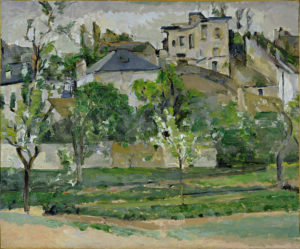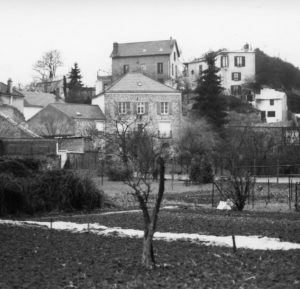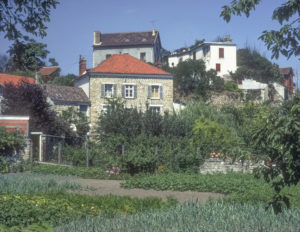R311 – Le Jardin de Maubuisson, Pontoise 1877 (FWN109)
Pavel Machotka
(Cliquer sur l’image pour l’agrandir)
The year 1877, part of which was spent again in Pissarro’s company, witnesses an intense concentration, in all of Cézanne’s work, upon the unity of the painted surface. Le Jardin de Maubuisson, Pontoise, illustrates one aspect of his development particularly well — what can be called his blockish style.
Where Pissarro’s view is that of a garden in full bloom, Cézanne’s is a study of the structure of the motif. Pissarro’s touch is light and flocculent, while Cézanne’s is systematic and built up of blocks of pigment. Whether the artists painted side by side is unclear, but if they did, then Cézanne may have taken more time, finding the trees fully leafed out toward the end and only some sparse petals still hanging on. In Cézanne’s version the dominating element is not a blooming tree but the peculiar house in the upper right, and there is a forceful movement in the space that curves up to and behind it which is not seen in Pissarro’s version. A twisted tree on the right also echoes the curving space.
Inherent to the concern with space is the complementary flatness of the canvas as a whole. Cézanne achieves this in large measure by making the near wall of the house parallel to the canvas plane (it is in fact more closely parallel to the front wall of the complex house on the hill); he also suppresses its windows and creates a blank surface which recedes and pushes out the whole upper right corner of the painting.
Adapted from Pavel Machotka, Cézanne: Landscape into art.
[1] For example, A. Mothe, Ce Que voyait Cézanne, 2011, pp. 56-59; Musée d’Orsay, Cézanne et Pissarro, Paris, 2006, pp. 168-169.
Quelques photos du site :







